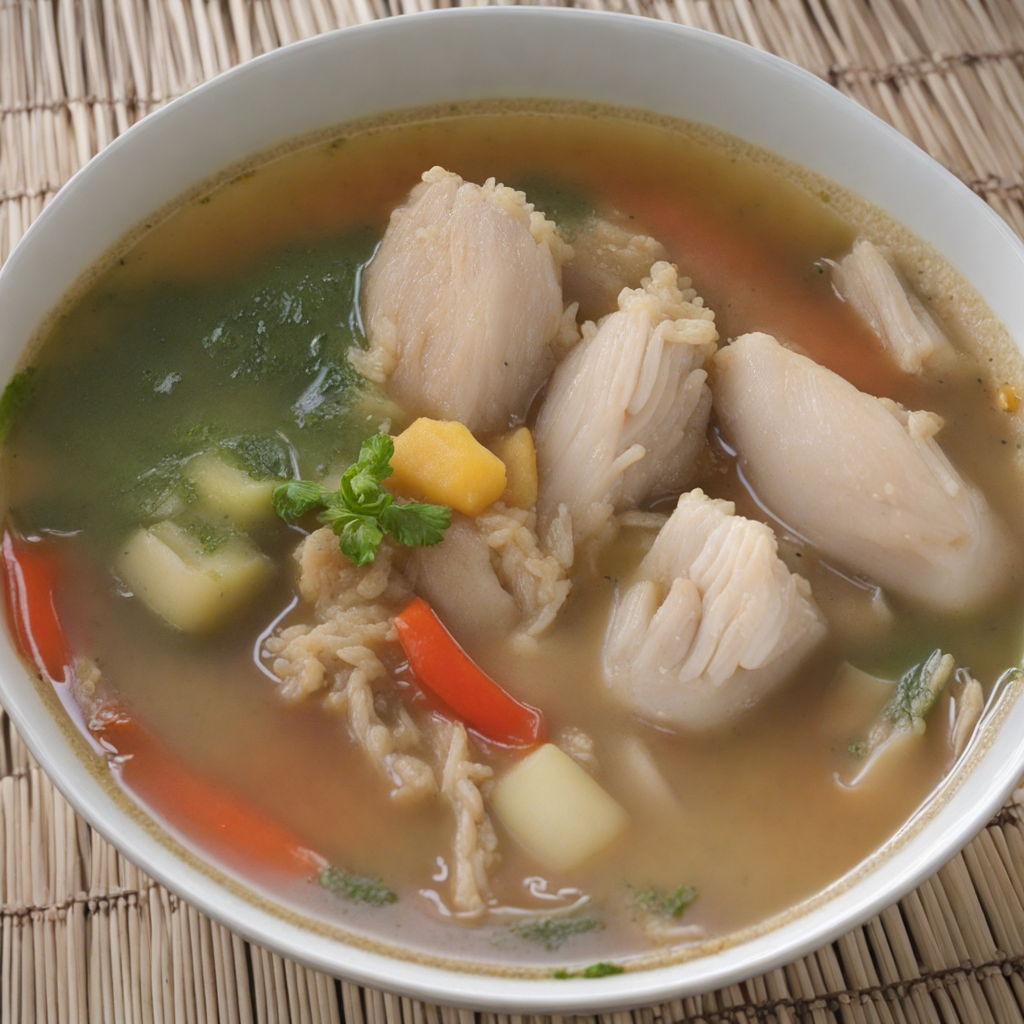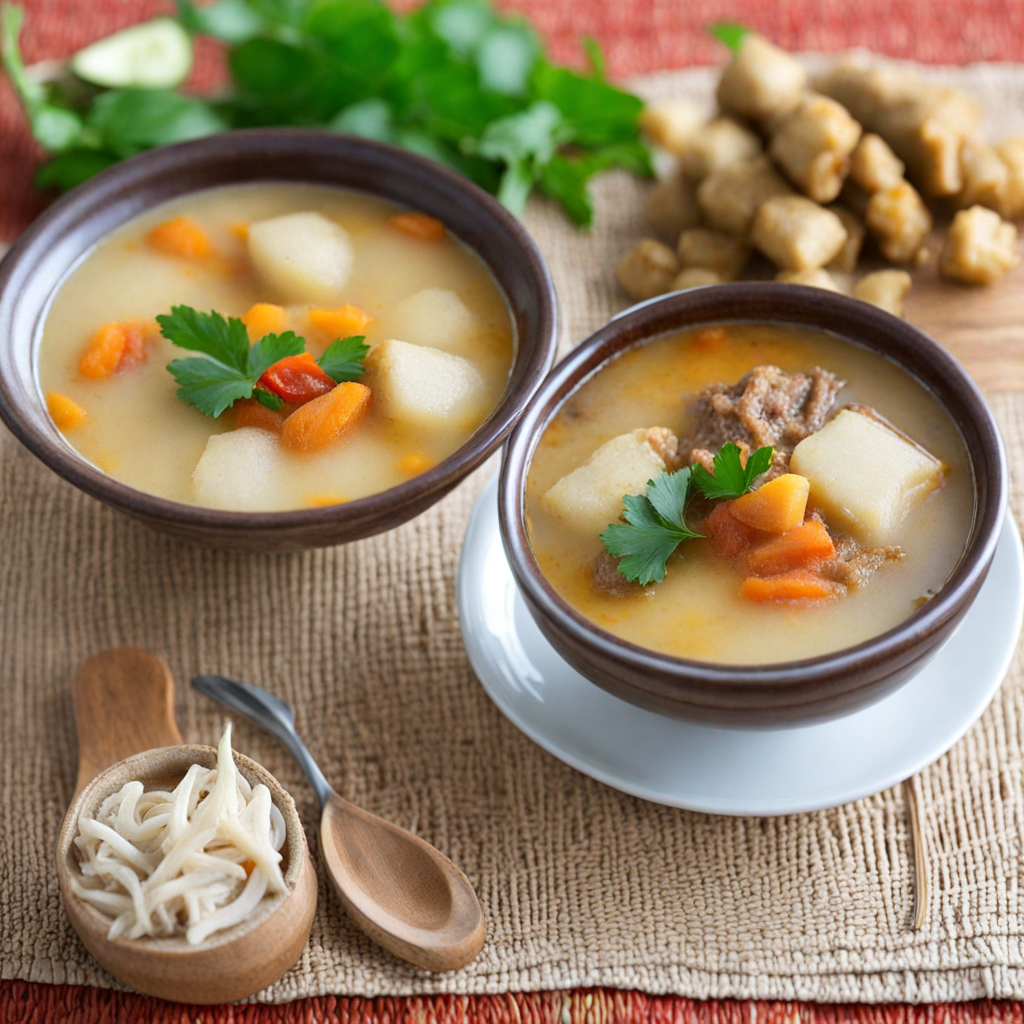Saoto Soup
Saoto Soup is a vibrant and aromatic dish hailing from Suriname, characterized by its rich and complex flavors. This savory soup is primarily made with a fragrant chicken broth that is infused with a blend of spices such as turmeric, ginger, and lemongrass. The addition of sliced chicken, often cooked to tender perfection, enhances the dish's heartiness, while vegetables like carrots and potatoes contribute a delightful texture and sweetness. The color of the broth is a beautiful golden hue, inviting you to explore the depths of its flavor profile with every spoonful. One of the defining features of Saoto Soup is its garnish, which elevates the dish to a whole new level. Typically, it is topped with freshly chopped green onions, fried shallots, and a boiled egg, adding layers of crunch and richness. Another popular addition is a side of rice or vermicelli noodles, allowing diners to customize their experience and create a satisfying meal. The soup is often served with sambal or chili paste, giving you the option to add a spicy kick that perfectly complements the warmth of the broth. The experience of enjoying Saoto Soup is not just about the taste; it’s also about the comforting aroma that fills the air as it simmers. Each bowl tells a story of Surinamese culture and its diverse influences, from Indonesian to Indian culinary traditions. As you savor the soup, you’ll appreciate the balance between the fragrant spices, the tender meat, and the fresh garnishes, making Saoto Soup a delightful dish to explore for anyone looking to embark on a new culinary adventure.
How It Became This Dish
Saoto Soep: A Culinary Journey Through Suriname Saoto Soep, a beloved dish originating from Suriname, is a fragrant and hearty chicken soup that encapsulates the rich tapestry of the country’s cultural heritage. This dish, with its vibrant flavors and aromatic spices, serves not only as a staple in Surinamese cuisine but also as a symbol of the nation’s diverse history and the melding of cultures that defines it. Origins The origins of Saoto Soep can be traced back to the Javanese immigrants who came to Suriname in the early 20th century, particularly after the abolition of slavery in 1863. Initially brought in as contract laborers to work on plantations, the Javanese brought with them their culinary traditions. Saoto Soep is believed to have evolved from the Indonesian dish “soto,” a term that encompasses various types of broth-based dishes throughout the archipelago. The adaptation to local ingredients and tastes gave rise to the unique Surinamese version. As Suriname is located on the northeastern coast of South America, its culinary landscape has been shaped by various influences over centuries, including Indigenous peoples, Dutch colonizers, African slaves, and Asian immigrants. The Javanese brought their aromatic spices and cooking techniques, and Saoto Soep became a definitive representation of this blend. While the original Indonesian soto typically features a rich broth flavored with turmeric, lemongrass, and ginger, Suriname's Saoto Soep incorporates local elements such as chicken, coconut milk, and a variety of vegetables. Cultural Significance Saoto Soep holds a special place not only in the hearts of Surinamese people but also in their communal life. It is often served at family gatherings, celebrations, and parties, embodying warmth and hospitality. The process of making Saoto Soep can be a communal activity, where families come together to prepare the dish, sharing stories and laughter as they chop vegetables and simmer the broth. The act of cooking and sharing this soup fosters a sense of community and belonging. The dish is also symbolic of Suriname's multicultural identity. Suriname is one of the most ethnically diverse countries in the world, with a population comprising various groups, including Creole, Javanese, Hindustani, Chinese, and Indigenous peoples. Each group has contributed to the culinary landscape of the country, and Saoto Soep stands as a testament to this harmonious blend. It serves as a bridge between different cultures, making it a dish that is celebrated across ethnic lines. Development Over Time Over the years, Saoto Soep has evolved in various ways, reflecting the changing tastes and available ingredients in Suriname. Traditionally, the soup was made using whole chickens, simmered for hours to extract the maximum flavor. The broth is enriched with spices like ginger, garlic, and lemongrass, creating a complex and aromatic foundation. Vegetables such as carrots, potatoes, and green beans are often added, alongside hard-boiled eggs and crispy fried onions as garnishes. As Suriname modernized and the influence of global cuisine spread, variations of Saoto Soep emerged. In urban areas, where convenience foods gained popularity, pre-packaged ingredients and ready-made broths started to appear. However, many Surinamese families still adhere to traditional recipes and cooking methods, valuing the authenticity and depth of flavor that comes from preparing the soup from scratch. In recent decades, the diaspora of Surinamese people around the world has also led to the globalization of Saoto Soep. As Surinamese communities settled in countries such as the Netherlands, the United States, and Canada, they brought their culinary traditions with them. Restaurants specializing in Surinamese cuisine began to pop up, introducing Saoto Soep to new audiences and adapting the dish to local tastes. For example, some chefs have incorporated ingredients that are more accessible to non-Surinamese consumers, such as different types of poultry or alternative vegetables, while still honoring the spirit of the original soup. Ingredients and Preparation The preparation of Saoto Soep is a labor of love, requiring attention to detail and a deep understanding of the balance of flavors. The key ingredients include chicken, which provides the primary protein; a variety of spices and herbs, such as turmeric, ginger, and garlic; and vegetables that complement the soup's richness. The soup is often served with a side of rice or noodles, allowing for a more filling meal. To make Saoto Soep, the chicken is typically boiled with water and a medley of spices to create a flavorful broth. After the chicken is cooked, it is shredded and returned to the pot, along with vegetables and additional seasonings. The soup is then simmered until all ingredients are tender and infused with flavor. It is traditionally garnished with fresh herbs, hard-boiled eggs, and crispy fried onions, adding texture and visual appeal. Conclusion Saoto Soep is more than just a dish; it is a cultural artifact that represents the rich, diverse history of Suriname. From its Javanese roots to its current status as a cherished comfort food, the soup encapsulates the stories of migration, adaptation, and community. Each bowl of Saoto Soep tells a tale of resilience and the enduring power of food to bring people together. In an age of globalization, where culinary traditions are often diluted or lost, Saoto Soep stands as a beacon of authenticity. It invites both locals and visitors alike to experience the vibrant flavors of Suriname and to appreciate the complex heritage that has shaped this remarkable dish. Whether enjoyed at a family gathering, a festive celebration, or a cozy dinner at home, Saoto Soep continues to warm hearts and nourish souls, embodying the spirit of Suriname’s rich cultural mosaic.
You may like
Discover local flavors from Suriname







